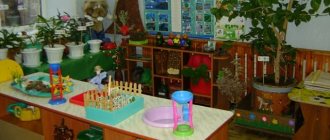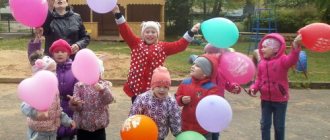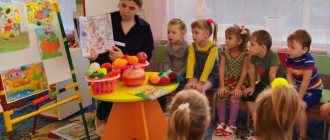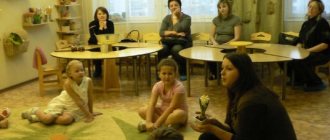Thematic meetings at preschool educational institutions
Borisova Victoria
Thematic meetings at preschool educational institutions
Thematic meetings are one of the interactive forms of interaction with parents, which is aimed at cooperation between families and preschool educational institutions in solving problems of education and upbringing of children in various educational areas, increasing the role and responsibility of parents in civic education and raising a child.
Methodology of organization and implementation.
A week before the announced meeting with parents, it is necessary to post an announcement that would detail the topic and form of the meeting, and also indicate the date, time and location of the meeting.
Information about the upcoming meeting must be known in advance; in order to set up parents for dialogue, it is necessary to hang up a stand on which the main issues that will be considered at the meeting with parents and preschool employees will be presented in a colorful form.
It is important to invite parents to the meeting , taking into account their work schedule. It is necessary to determine how much time should be required to hold a meeting, how to properly arrange the tables in the room in which the meeting . To attract the attention of parents to the importance and necessity of individual items, meetings can be held in music rooms, a methodological room, a gym, an art or environmental studio. the meeting in the room , parents begin to perceive these rooms through the eyes of their children, understanding their significance in organizing the pedagogical process.
During the meeting with parents, the administration of the preschool institution must take into account the presence of children who will be in the room with their parents until the end of the meeting . Therefore, it is necessary to organize the employment of children during the meeting and, if necessary, provide them with food during the meeting .
In the room where children are, it is necessary to think about where to organize a temporary locker room for parents, asking them in advance to take replacement shoes.
Throughout the meeting with parents, it is necessary to observe the laws of dialogue, according to which it is important not to violate the rights of parents to feedback, not to forget about time and to end the meeting at the exact time, respecting the time of not only parents, but also your fellow teachers. If some issues were not covered the meeting thematic meeting .
Sample topics for thematic meetings in different age groups.
Junior group: about the skills of confidential communication with a child in the family; the child’s peace of mind is associated with the style of family relationships;
Middle group: about non-violent methods of influencing a child or how to “save yourself”
playing when I'm angry with my child; how to listen to a child in order to hear him; animals in the house;
Senior group: how to speak to a child correctly; how not to devalue the experiences and events of a child’s life; what is your child like in terms of friendship with peers;
Preparatory group: family well-being on the threshold of the child’s school life; about the realistic expectations of parents from a future first-grader; why play school with your child;
Conversation with parents on the topic: “Children’s questions and how to answer them.”
Contestant:
Matyuk Natalya Mikhailovna
Teacher 1st category
AUDO "Kindergarten Topolek"
Uvat municipal district"
The purpose of the consultation is to show the importance of children’s questions in the development of a preschooler’s curiosity and to equip parents with the skills to answer them correctly.
Preparatory work.
Homework. On a day off, observe your child and write down the questions he asked family members.
What do preschoolers ask?
The content of children's questions is varied. Children ask about the objects around them, about distant planets and space, about the phenomena of social life, about nature, the origin of man and all life on Earth, war and peace, norms and rules of behavior, the meaning and significance of individual words, etc.
And now we will watch a video film. “What do children ask?” After watching, we continue the conversation.
Invite parents to read out the questions they have collected, which will serve as the basis for drawing conclusions about the variety of children’s questions.
Many children's questions are based on a cognitive motive. Children ask them because of their curiosity, when they lack knowledge, they strive to supplement it, clarify it, and acquire new ones.
The source of cognitive questions is the child’s varied experiences. Questions arise during direct acquaintance with any objects and phenomena, in communication with adults and peers, and sometimes are the result of his own reasoning.
Throughout preschool age, children's questions also change in form. Kids are interested in the name of objects, their properties, qualities. They ask questions in the form where? Who? What? Which? When?
Children of middle preschool age are characterized by active mental processing of impressions about the world around them.
The questions become more complex and are expressed in the form why? Why?
In older preschool age, a sequence of questions about some object or phenomenon is typical.
Children at the age of five ask the greatest number of questions.
But in older preschool age, the number of questions begins to decrease, why?
The decline in children's questions is associated with the conditions of education and training of older preschoolers: adults do not encourage their curiosity and often express displeasure about questions: “I'm tired of your questions!” Shut up, you’re already big, but you keep asking and asking!”
As a result, children develop a prejudice towards their questions: they think that this is to show their ignorance.
Game exercise "THE REFLECTION".
"Hat of questions."
The meaning of the game. Questions for reflection are written on the pieces of paper, put them in a hat, and parents take turns drawing out and reading out the question of who will get what (you can work in pairs).
Questions:
How does your family approach children's issues?
Do you think that children's questions and correct answers to them contribute to the development of the child?
What is your child asking?
Is it possible to judge his curiosity and interests based on a child’s questions?
Which member of your family does your child turn to most often and why?
What questions from your child baffle you?
Which questions are easy to answer?
Is your child always satisfied with the way you answer his questions?
When answering children's questions, do not strive for exhaustive and complete answers. When answering a child’s question, encourage him to new thoughts and observations. It is sometimes advisable, instead of an answer, to offer the child a counter question: “What do you think?” The child will not always make the correct guess, but the fact that he will think about it and look for the answer on his own will have a beneficial effect on the development of his curiosity.
Now let's look at the requirements for adults' answers to children's questions.
The baby begins to understand early that dad, mom, grandma, grandpa
have different attitudes to his questions. More often than not, he turns to that family member who, after listening carefully to the question, answers seriously and interestingly. This implies a requirement, a respectful, careful attitude towards them, a desire to understand what prompted the child to ask.
The next requirement is brevity, clarity, certainty of the answer. In this case, it is necessary to take into account the level of mental development of the preschooler and rely on his life experience.
In the preschool years, it is dangerous to turn a child into a know-it-all, who thinks that he has heard about everything, learned everything, but in fact he simply remembered a lot, but did not understand. Therefore, in cases where the answer to a child’s question is a message or information that is inaccessible to his understanding, it is appropriate to say: “You are too young to understand this. Soon you will go to school, then you will learn a lot, and you will be able to answer your own question.”
Let's look at a few examples:
Dad and six-year-old Olya are looking at an illustrated book about the zoo. The girl had a question: “Why does the lion have such yellow skin?”
Listen to the conversation that took place between father and daughter, pay attention to counter questions that encouraged the child to independently search for an answer.
Dad. Remember where lions live in the wild?
Olya. In a desert.
Dad. What do you think a desert is?
Olya. Grass and trees do not grow in the desert and there is sand all around.
Dad. What color is the sand?
Olya. Yellow! Understood! Lions are yellow to make it easier for them to watch for prey in the desert.
Dad. Right. The lion has a camouflage coloring of its skin. Also, what animals do you know whose skin color helps them camouflage and remain invisible?
Olya. In polar bears. They live in the north, there is snow and ice, that’s why their skin is white.
Dad. Are there animals in our forests with camouflage colored skins?
Olya. Eat. This is a squirrel and a hare. In winter they change their fur coats to light ones so as to be invisible.
Dad. Why do the squirrel and the hare change their coats in winter? Do they attack anyone like a lion in the desert?
Olya. No, they themselves hide from their enemies.
Dad. Think about why animals need camouflage coloring on their skins?
Olya. For some animals it was easier to attack, and for others to hide from enemies.
Additional questions from an adult lead the child from ignorance to knowledge and clarification of his ideas.
While on a walk in the forest, five-year-old Petya saw a beautiful butterfly with orange wings. Mom didn’t know what it was called, but she invited her son to carefully examine and remember the appearance of the butterfly: “At home, we’ll look in the book and find out its name.” Petya, after observing the butterfly, discovered that there were not many black dots on its wings. At home, my mother took out a book, and together they spent a long time looking at the butterflies depicted in it. Finally they found one that Petya was interested in. It was called the many-eyed fiery one. Mom asked: “Do you understand why it is called fiery? That's right, for the orange color of the wings. Why do you think there are many eyes?” Petya expressed his guess: “Probably because of the black dots, they look like eyes.”
By turning to books with your child for an answer to a question, you instill in the preschooler respect for knowledge. The child begins to understand that knowledge is acquired in different ways, the most interesting and exciting medium of which is reading.
Five-year-old Sasha, while helping his grandmother care for strawberries in the garden, became interested in how berries are made from flowers. The grandmother invited the boy to watch the formation of strawberry fruits. She drew her grandson’s attention to how the ovary appeared, how it began to grow, change in shape and color. Long-term observations directed by his grandmother enriched the child with knowledge about the growth and development of strawberries. Based on this knowledge, Sasha was able to explain the process of formation of currants, gooseberries, cucumbers, zucchini, and tomatoes from flowers. He developed a basic understanding of the growth and development of plants, which would later help him in studying botany at school.
A preschooler can get a convincing answer to many questions as a result of observing the life around him. The parents' task is to involve the child in them.
The result of our conversation.
The ability to intelligently answer a child’s question is a great art. Mastering such an art is a feasible task for parents and educators.
Application
Memo for parents on the topic “How to answer children's questions?”
Treat your child's questions with respect and don't brush them off. Listen carefully to the child’s question, try to understand what interested the child in the subject or phenomenon that he is asking about.
Give answers that are brief and understandable to a preschooler, while avoiding complex words and bookish figures of speech.
The answer should not only enrich the child with new knowledge, but also encourage him to further reflection and observation.
Encourage your child’s independent thinking by answering his question with a counter question: “What do you think?”
In response to your child’s question, try to involve him in observing the life around him, read him a book, and look at illustrative material together.
When answering a child’s question, influence his feelings, cultivate sensitivity, humanity, and tactfulness towards the people around him.
If answers to your child’s questions require the communication of complex knowledge that is inaccessible to the understanding of a preschooler, do not be afraid to tell him: “You are still small and will not be able to understand much. You will study at school, you will learn a lot, you will be able to answer your own question.”
Literature:
Sukhomlinsky V.A.
“I give my heart to children.” /Fav. ped. op. - M. 1979. - T. 1. - P. 56.
Vinogradova N.F.
“To the educator about working with the family.” Moscow. "ENLIGHTENMENT" 1989
Share
Situational conversations with parents. Subject.
- Situational conversation with parents about the well-being of children.
- Situational conversation with parents about the rules of behavior in the group.
- Situational conversation with parents “Why does a child need to be able to dress himself?” Fix the sequence of dressing and undressing.
- A situational conversation with parents about why the child needs time off from the teacher to go home.
- Situational conversation with parents about the need to wash hands before eating.
- A situational conversation with parents about the rules of behavior with each other, about the need to be polite, not to fight, not to be greedy.
- A situational conversation with parents about how to properly ask the teacher for time off.
- Situational conversation with parents about “How friendly guys play in a group”
- Situational conversation with parents about the benefits of proper nutrition. About the ban on bringing sweets to the group.
- A situational conversation with parents about how to behave at a holiday or performance.
- Situational conversation with parents about table manners.
- A situational conversation with parents about the work of a teacher or assistant teacher.
- Situational conversation with parents “About the rules of conduct in kindergarten.”
- A situational conversation with parents about the need to maintain order in the group.
- A situational conversation with parents about what children are doing in kindergarten.
- Situational conversation with parents about the need for morning exercises.
- A situational conversation with parents about the need to continue teaching children to use cutlery.
- Situational conversation with parents “The child’s favorite dish.”
- Situational conversation with parents. Help from parents in arranging the playground.
- Situational conversation with parents about food.
- Situational conversation with parents “What are the benefits of vegetables and fruits?”
- Situational conversation with parents about the weather.
- Situational conversation with parents “Your child’s health”
- Situational conversation with parents “Why does a child need to be neat?”
- Situational conversation with parents about cleanliness and neatness.
- Situational conversation with parents “How to dress a child warmly.”
- Situational conversation with parents “Why does a child need a handkerchief?”
- Situational conversation with parents “How to dress a child for a walk in winter”
- Situational conversation with parents about the rules of behavior in kindergarten.
- A situational conversation with parents about whether your child is fighting.
- A situational conversation with parents about gifts given for the New Year.
- Situational conversation with parents “Teaching a child to fold things correctly and neatly”
- Situational conversation with parents “What to do to prevent your child from getting sick in winter”
- A situational conversation with parents about the need for children to say hello in the morning.
- A situational conversation with parents about the rules of behavior in the music room during a matinee.
- Situational conversation with parents about ice.
- Situational conversation with parents about the need for vaccinations.
- Situational conversation with parents about safe toys.
- Situational conversation with parents about the properties of water.
- Situational conversation with parents about the dangers of sweets.
- Situational conversation with parents to familiarize themselves with the work schedule on holidays.
- A situational conversation with parents about games that children can play and which cannot.
- A situational conversation with parents about the right clothes for a walk.
- Situational conversation with parents about the rules of behavior in public places.
- A situational conversation with parents about the need to clean up toys after themselves.
- Situational conversation with parents about politeness and etiquette.
- A situational conversation with parents about the need to follow the rules of safe behavior in a group and on a walk.
- A situational conversation with parents about how things should be in the closet.






